Part I of Wine Lister’s annual in-depth Bordeaux report: For better, for worse, examines the state of the market for Bordeaux wines, in the context of 2019 en primeur.
As well as providing insight into the wine trade’s latest position on key wines of the region, the study examines Bordeaux’s disconnect between consumer popularity and its market performance at the start of 2020 (exacerbated by recent macro-economic hits to the UK, Hong Kong, and the US).
As illustrated below, Bordeaux has achieved the slowest price growth on the secondary market since May 2014, while Piedmont has seen the most impressive growth – likely due to increasing attention given to the region, and the rarity factor of many of its top wines, from which Burgundy also benefits.
 The price performance of Bordeaux compared to four other key fine wine regions: Burgundy, California, Piedmont, and Tuscany. The price indices comprise the top five wine brands in each respective region.
The price performance of Bordeaux compared to four other key fine wine regions: Burgundy, California, Piedmont, and Tuscany. The price indices comprise the top five wine brands in each respective region.
A glance at its price performance since May 2019 tells a similar, if more unnerving story – Bordeaux has floundered over the past year, down nearly 5%.
Despite its price performance difficulties, Bordeaux nonetheless continues its legacy as the most popular wine region by a large margin, based on monthly searches made on Wine-Searcher.
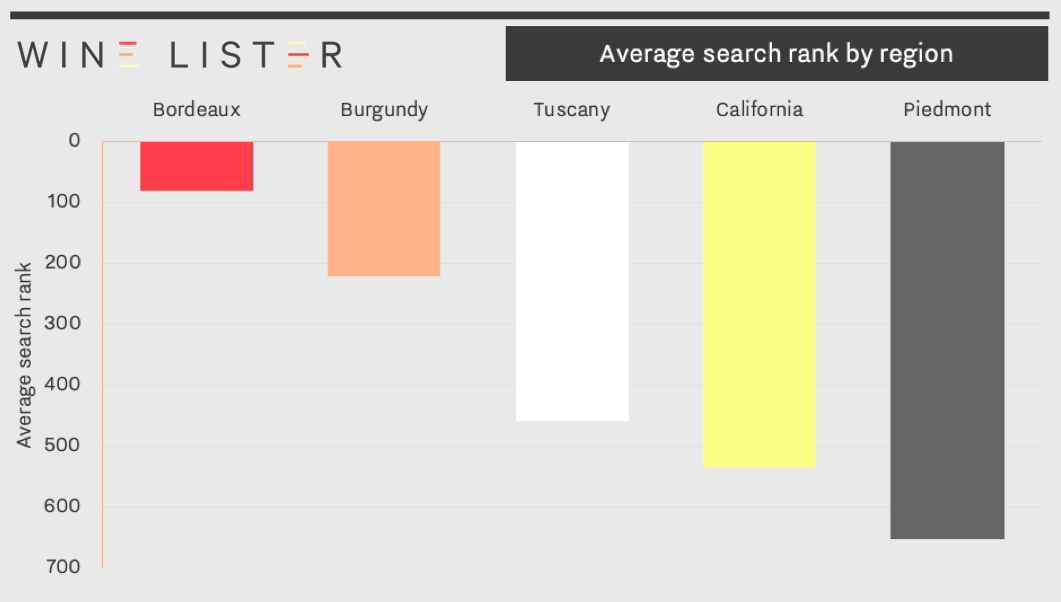 The average search rank of Bordeaux compared to four other key fine wine regions: Burgundy, California, Piedmont, and Tuscany. Results are based on the average searches on Wine-Searcher for the 50 top-scoring wines per region over the last year.
The average search rank of Bordeaux compared to four other key fine wine regions: Burgundy, California, Piedmont, and Tuscany. Results are based on the average searches on Wine-Searcher for the 50 top-scoring wines per region over the last year.
Irrespective of its price performance struggles, Bordeaux remains a focus of fine wine buyers – within the trade and beyond – all over the world. The en primeur campaign is a wheel that just keeps on turning, even in spite of a global pandemic. Trade and consumers alike can’t help but back Bordeaux, for richer and poorer.
More insight into the success of the 2019 en primeur campaign will be included in Part II of this study. In the meantime, visit the Analysis page to purchase Part I, or download using your Pro subscription (available in both English and French).
With the Bordeaux 2019 en primeur campaign now behind us, Part I of Wine Lister’s 2020 Bordeaux Study examines the results of our latest in-depth trade survey. Answered by 50 key players across major fine wine markets, the results provide insight into the wine trade’s latest position on the region, including its level of confidence in specific wines.
The trade’s faith in Bordeaux brands has increased on the whole since last year, with more Bordeaux wines moving up in their confidence rating than down. For the fourth consecutive year, no Bordeaux wine received a confidence rating of 10/10. Brands that have retained their 9/10 confidence rating since last year are Lafleur, Le Pin, Margaux, Mouton, Petrus, and Vieux Châteaux Certan.
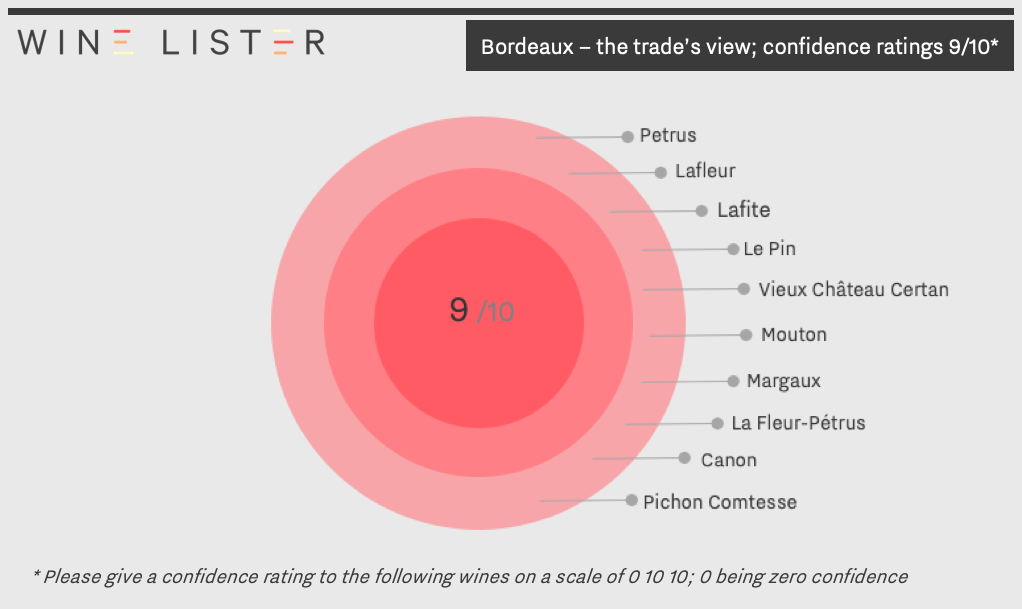
Joining them in 2020 are Canon, La Fleur-Pétrus, Lafite, and Pichon Comtesse, while Latour has moved down a rating since last year, to 8/10. The survey was, however, conducted prior to the first growth’s successful 2012 release (27th May) at c.£350 per bottle, marking its first release of a vintage exclusively as mature stock.
There are 28 Bordeaux wines that earn a confidence rating of 8/10 in 2020, with nine joining them since last year: Angélus, Ausone, Belair-Monange, Carruades de Lafite, Grand-Puy-Lacoste, La Mission Haut-Brion, Montrose, Palmer, and Pavillon Blanc.
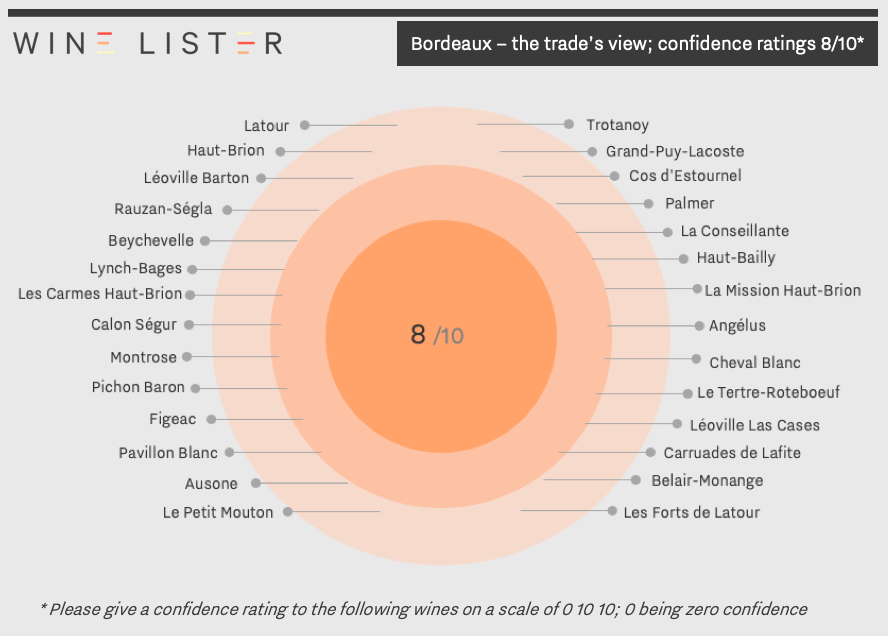
Though Margaux’s Pavillon Rouge moves down to a rating of 7/10 in 2020, three younger siblings of first growths stay at a rating of 8/10: Carruades de Lafite, Le Petit Mouton, and Les Forts de Latour.
Part II of the Bordeaux 2020 study, including a score breakdown of 2019s, and further retrospective analysis of the en primeur campaign, will be published shortly. Watch this space.
In the meantime, visit the Analysis page to purchase Part I, or download using your Pro subscription (available in both English and French).
The final stretch of en primeur releases came yesterday – Tuesday 23rd June (excepting Petrus and Le Pin, which are generally always released at the end of the campaign).
First out of the blocks was the en primeur darling, Les Carmes Haut-Brion. Wine Lister’s CEO, Ella Lister, believes Director, Guillaume Pouthier and his team have produced another stunning effort in 2019, continuing their streak of achieving consistently high scores from critics since the 2014 vintage. She names the wine “heady” and “hypnotising” with aromas of “dark fruit, graphite, and mature roses” on the nose. On the palate she describes the wine as “silky, seductive, and generous”, adding that it is “incredibly pure”.
Aside from Les Carmes Haut-Brion’s clear qualitative success, the additional factors of its small production levels and smart en primeur pricing once again make it one of the most obvious buys of the campaign. One top UK merchant tells me, “we sold out in a matter of seconds”. The bittersweet irony of its huge demand is, of course, that it is reserved only for the lucky few. Indeed, its popularity has soared since the release of the 2016 vintage, which has more than doubled its price since. Its impressive price performance post en primeur release (the 2019 released at £58, 28% below the current price of the 2018) is the cherry on Bordeaux buyers’ favourite cake – Les Carmes Haut-Brion is, perhaps unsurprisingly, the number one Bordeaux wine voted by the trade to have seen the sharpest rise in demand, as shown in the chart below.
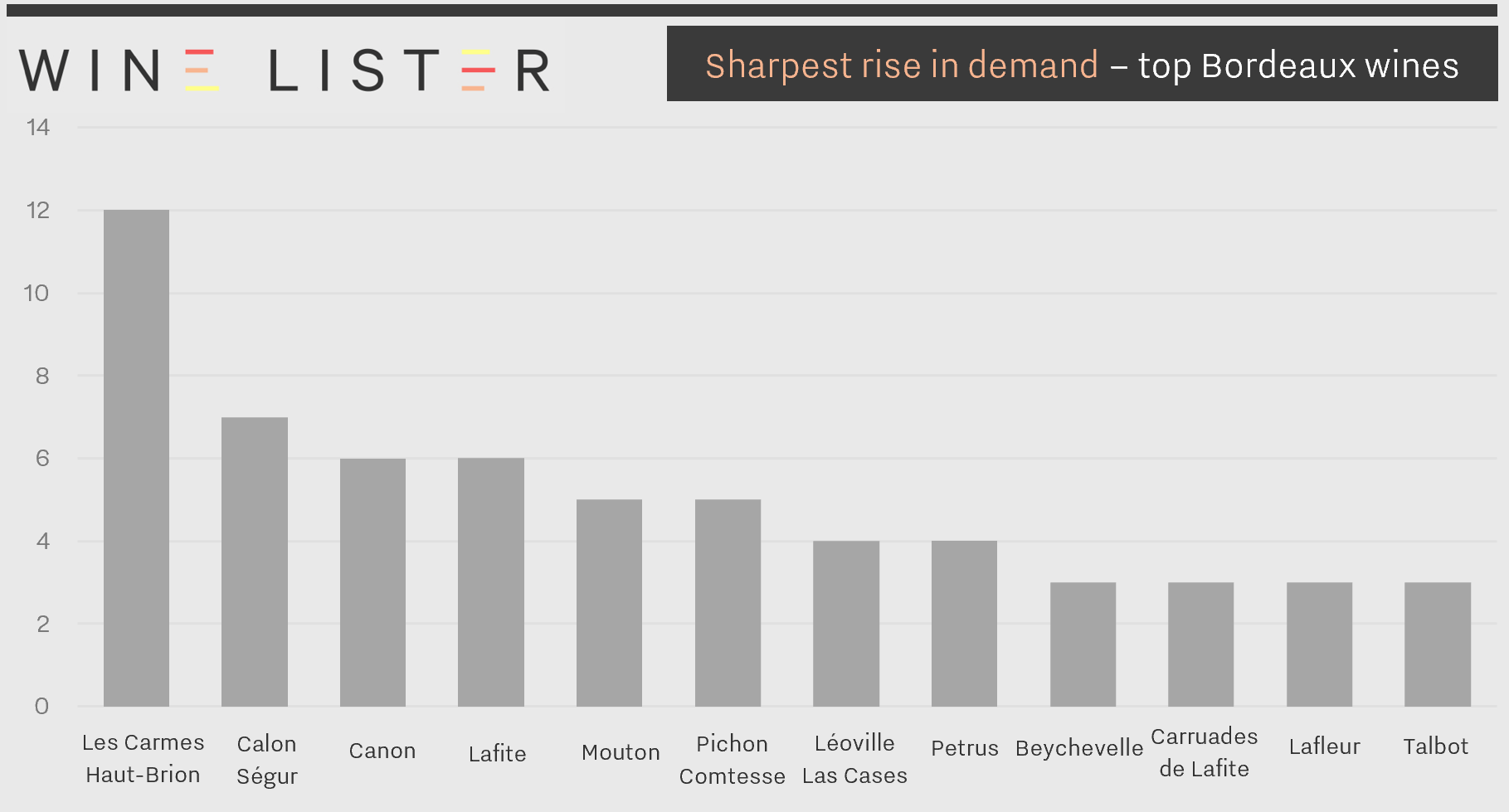 Results from Wine Lister’s 2020 trade survey show Les Carmes Haut-Brion achieves first place for sharpest rise in demand of Bordeaux wines.
Results from Wine Lister’s 2020 trade survey show Les Carmes Haut-Brion achieves first place for sharpest rise in demand of Bordeaux wines.
Joining the fray of hot ticket releases from yesterday was Vieux Château Certan. Wine Lister partner critics were collectively impressed with the 2019, placing its quality on par with the 2018 (which achieves a WL score of 96). Writing for JancisRobinson.com, James Lawther describes the 2019 as a “classic VCC”, while Neal Martin for Vinous hails it a “brilliant follow-up to the 2018”. Releasing at £177 per bottle (in-bond), the latest vintage comes onto the market 20% below the current market price of the 2018.
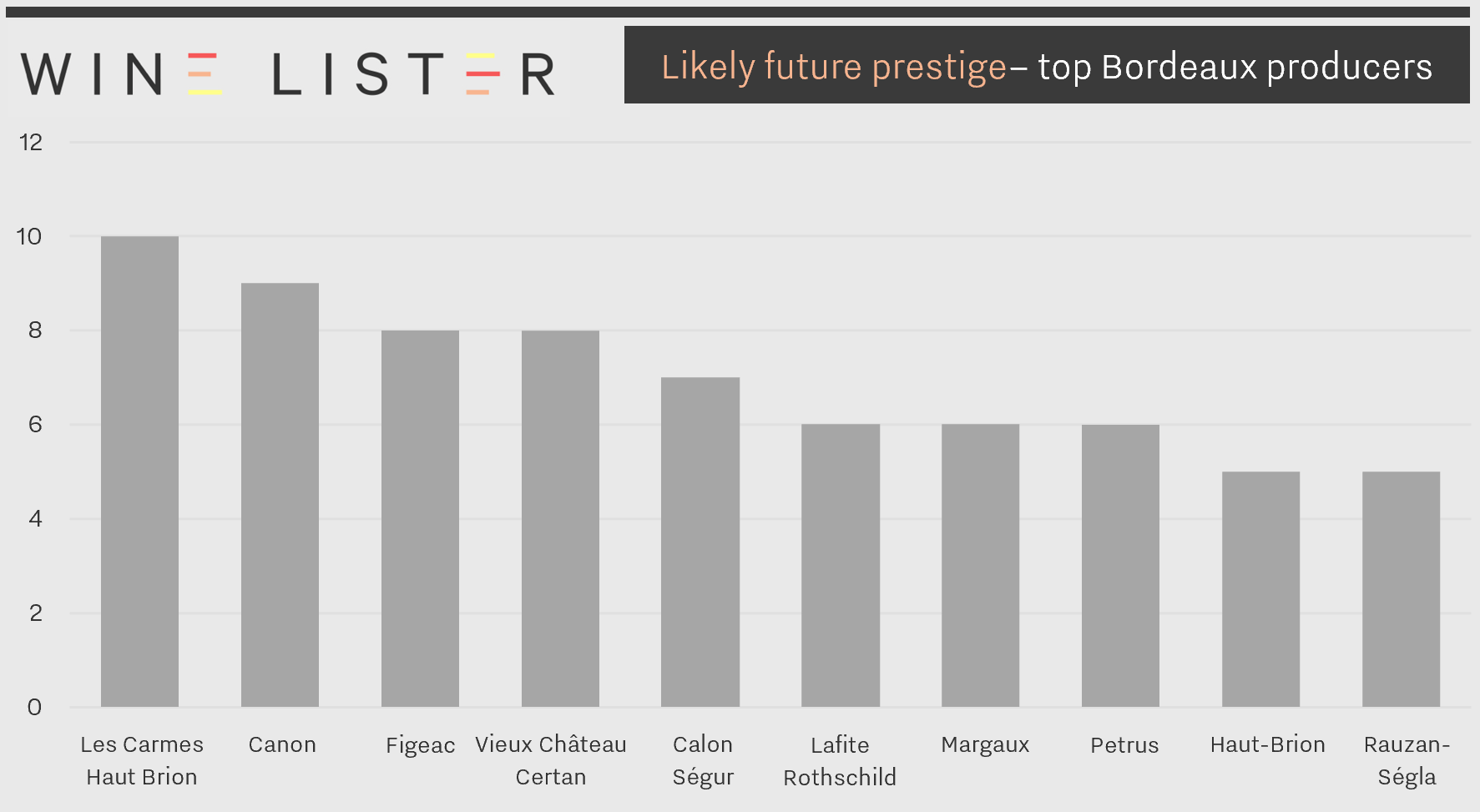 Four releases from Tuesday 23rd June land within the top 10 Bordeaux wines to be voted by key members of the trade as most likely to see future prestige – Les Carmes Haut-Brion, Vieux Château Certan, Canon, and Rauzan-Ségla.
Four releases from Tuesday 23rd June land within the top 10 Bordeaux wines to be voted by key members of the trade as most likely to see future prestige – Les Carmes Haut-Brion, Vieux Château Certan, Canon, and Rauzan-Ségla.
Chanel siblings Canon and Rauzan-Ségla also released their 2019s onto the market yesterday, adding weight to a day full of releases set for bright futures (see image above).
Saint-Émilion star, Canon, released its 2019 to the market at £73 per bottle (in-bond) – 23% below current prices of the 2018 and 2016 vintages. The Canon team characterise 2019 as a “metronome” vintage, referring presumably to the swinging back and forth between climatic extremes. The wet spring and the risk of frost, followed by the strong heat of the summer resulted finally in a perfect finish to the vineyard cycle at the time of harvest, and a wine that sings at perfect pitch. Lister describes Canon 2019 as a “sweet, seductive temptress”, with “voluptuous, racy acidity”, which Director Nicolas Audebert tells us, “2019 is a combination of 2015 and 2016”.
Canon’s Margaux sister, Rauzan-Ségla, also joined the stage, at £57 per bottle (in-bond). A “luscious”, and “lithe” wine, Lister notes the 2019 has “melting fruit, from red to black and back”, and a “toasty, flirty, refined length”. Entering the market 34% below the current price of the 2018 vintage, and offering the second most generous discount on 2018 market prices of the entire campaign (behind only Lafleur), this is sure to see high levels of demand.
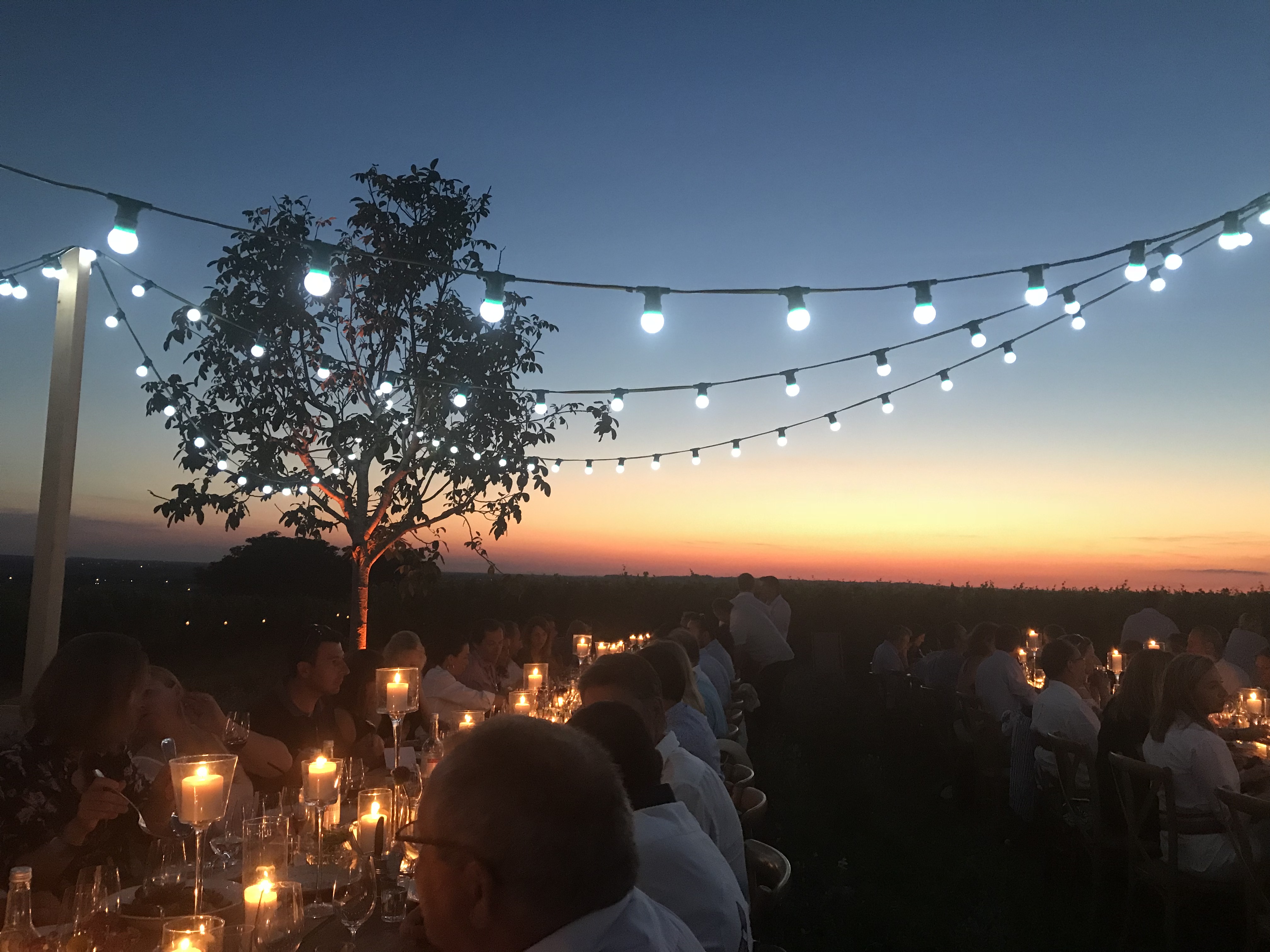 A different time – a throwback to 2018 and a celebration at Château Berliquet, of its acquisition by the Chanel group.
A different time – a throwback to 2018 and a celebration at Château Berliquet, of its acquisition by the Chanel group.
The Chanel group’s new baby, Berliquet, is also growing up fast, releasing its 2019 at £34 per bottle (in-bond). Lister describes “ripe, juicy strawberries” on the nose, adding that it is “very complete, accomplished, and reassuring, with a mineral lift”. On the palate, she finds Berliquet 2019 “rich, full, but very clean-lined”, with “lovely acidity which brings out definition on the finish”. Judging by the immense success of its big siblings, Berliquet has a bright future ahead, and the 2019 is worth snapping up.
Also released yesterday were: Beau-Séjour Bécot and Beauséjour Héritiers Duffau Lagarosse
Today is the 12th working day since the first major 2019 en primeur release, and over 60 wines are already out.
Among others, the last couple of days have seen the 2019 release of another first growth, a Pauillac powerhouse brand, and a major up-and-comer.
Haut-Brion released its red and white grands vins yesterday, at £295 and £560 per bottle in-bond respectively. While the red enters the market a solid 25% below the current market price of the 2018, the white is the campaign’s most expensive wine yet, and offers a smaller discount, of 5% on 2018.
Following Mouton Rothschild’s lead, Haut-Brion’s red looks well-priced within the current economic context, though buyers may note that the 2014 is available on the market around the same price. The 2012 also looks good – earning a WL score of 96, it is a Wine Lister MUST BUY (and available for c.£260 per bottle in-bond).
Also released from the Clarence Dillon family are Haut-Brion’s baby brother, Le Clarence (at c.£100 per bottle in-bond), and cousins La Mission Haut-Brion red and white. Of the two flagship reds, Haut-Brion is likely the stronger horse to back, based on its first growth status, as well as its position according to the trade among top Bordeaux wines for future prestige (see below).
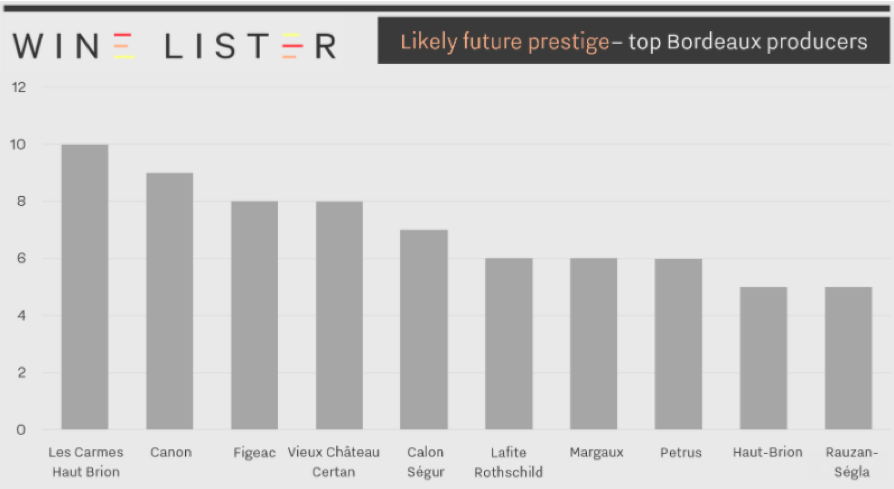 According to Wine Lister’s 2020 trade survey, Haut-Brion is one of top Bordeaux wines most likely to be worth including in collectors’ future cellars.
According to Wine Lister’s 2020 trade survey, Haut-Brion is one of top Bordeaux wines most likely to be worth including in collectors’ future cellars.
Three further pairs of releases from Pessac-Léognan have emerged over the last two days, comprising Malartic-Lagravière, Latour-Martillac, and Carbonnieux.
On Thursday 10th June, Pauillac star-brand Lynch Bages was released, and has resulted in an onward UK selling price of c.£66 per bottle in-bond. Wine Lister’s CEO, Ella Lister, tasted it last week, and found it to be “lifted, precise”, and “a classic”. The price positioning under £70 has reportedly been well-received.
Haut-Batailley was also introduced to the market, at £36 per bottle in-bond. As its second en primeur release under Cazes ownership (the same family as Lynch Bages), the 2019 is 20% under the current market price of the 2018. Following a repositioning of Haut-Batailley’s pricing during en primeur last year, the 2019 release looks good value – the wine’s strong reputation will likely only become stronger with a new wave of investment, and prices are likely to rise accordingly. Lister describes Haut-Batailley 2019 as “pretty”, “elegant”, and “very harmonious”, with a “long, saline, dark chocolate finish” – this is a wine to buy now.
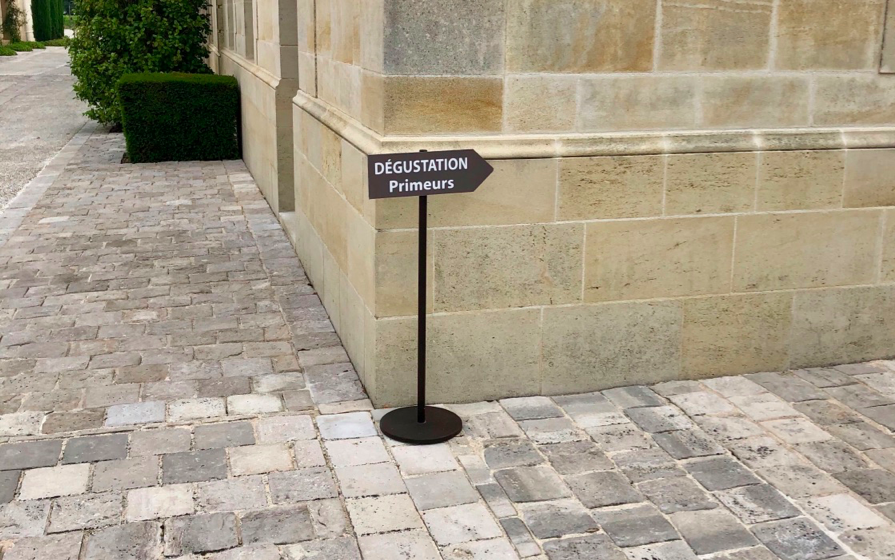 Better late than never – Wine Lister’s CEO, Ella Lister, has now tasted the majority of Bordeaux 2019s. Watch this space for her favourites, and Bordeaux 2019 MUST BUYs coming soon.
Better late than never – Wine Lister’s CEO, Ella Lister, has now tasted the majority of Bordeaux 2019s. Watch this space for her favourites, and Bordeaux 2019 MUST BUYs coming soon.
One further release for each side of the river caught Wine Lister’s eye this week: La Gaffelière 2019 was released 13% beneath the current 2018 market price. The château’s director, Thomas Soubes, told Wine Lister that he was very happy with the quality of their 2019, and Lister concurs – she finds the wine “serious” and “charming”, with “velvet tannin” and “seductive red fruit”. La Gaffelière continues to present excellent value for its impressive quality, relative to wines sharing the Saint-Emilion Grand Cru Classé “B” classification.
Calon Ségur 2019 was also released yesterday. As one of the top rising stars of Bordeaux, its 2019 came onto the market 10% below the 2018 release price, but crucially 31% below 2018’s current market price. Calon Ségur is one of the “poster children” for the true benefits of buying en primeur. Lister found Calon Ségur 2019 to be “perfumed”, “juicy”, and “unctuous”, with “spice on the mid-palate” and a “saline, super-precise finish”. As ever, this is worth snapping up before its price inevitably increases post en primeur release.
Also released during the same period were: Cantenac-Brown, Capbern, Clos Fourtet, Clos René, Cos Labory, Kirwan, Monbousquet, Moulin Saint-Georges, Pavie, Phélan Ségur, Pibran, and Suduiraut.
Keep up to date with further Bordeaux 2019 en primeur releases through Wine Lister’s dedicated en primeur page.
As en primeur 2018 picks up pace, we consider the 10 Bordeaux wines that any fine wine collector should acquire for their collection. These are based on the results of Wine Lister’s latest Founding Member survey, gathering the views of over 50 key players in the global fine wine trade.
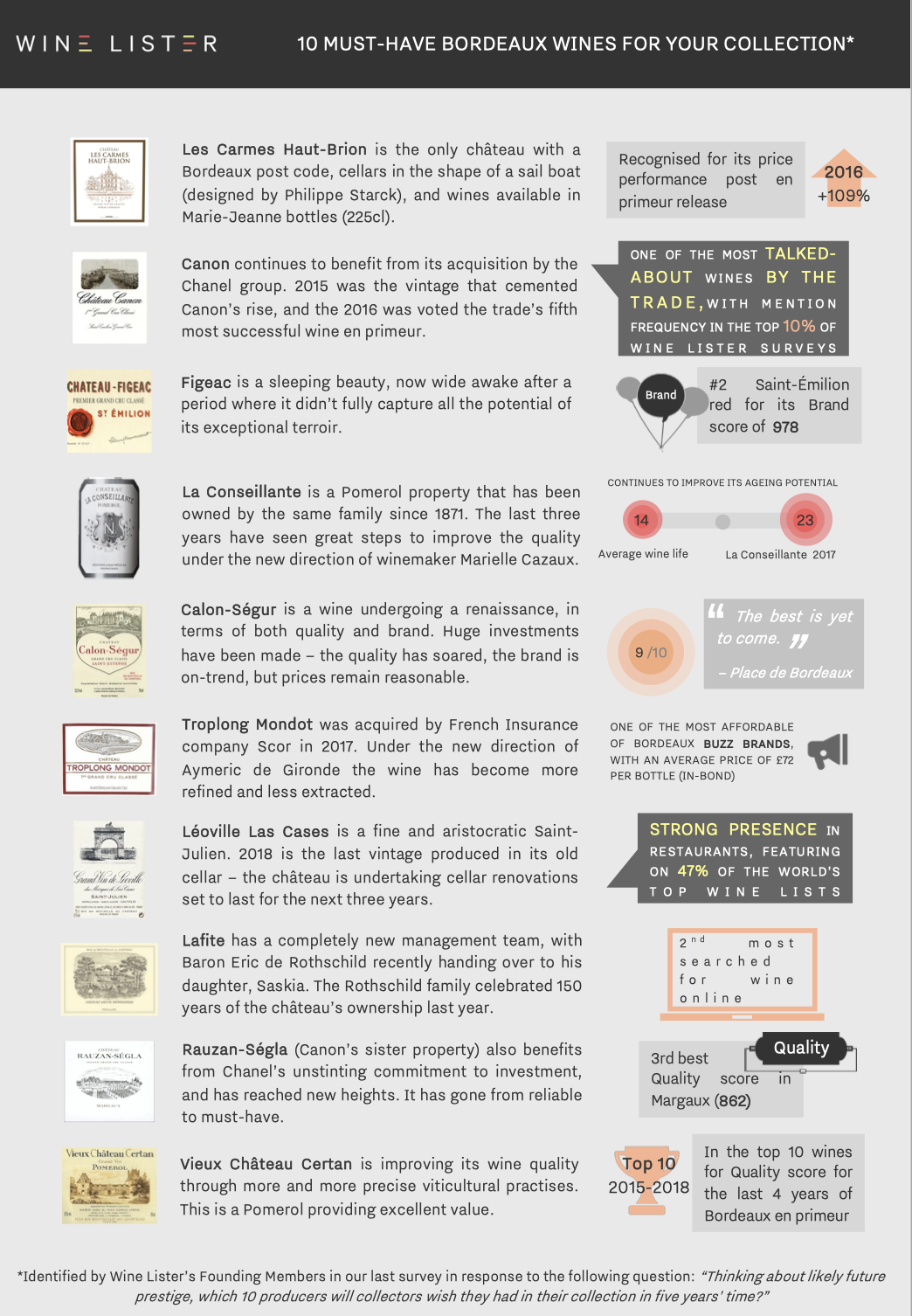
You can download this slide here: 10 must have Bordeaux wines for your collection
Yesterday we examined Wine Lister founder, Ella Lister’s top left bank picks from the recent re-tasting of 204 Bordeaux 2016s, now in bottle.
Almost as many wines stood out across appellations on the right bank, from a tasting the following day of 171 wines – testament to the fantastic quality available across the board in 2016. There is no doubting 2016 is a great vintage in Bordeaux. Tasting these wines from bottle only served to confirm the Wine Lister team’s enthusiasm during en primeur tastings in the spring of 2017. Revisit our blog post from the time for details of the unusual weather conditions behind this vintage.
Wine Lister right bank highlights include 11 Saint-Emilion wines vs. 10 in Pomerol, and the top pick overall was Figeac, which was “intellectual”, “fine-boned” and “gourmand”.
Several of its well-known Saint-Emilion neighbours also made the cut into Wine Lister tasting highlights, including Canon ( “feather-light, but generous”), Clos Fourtet, and La Gaffelière.
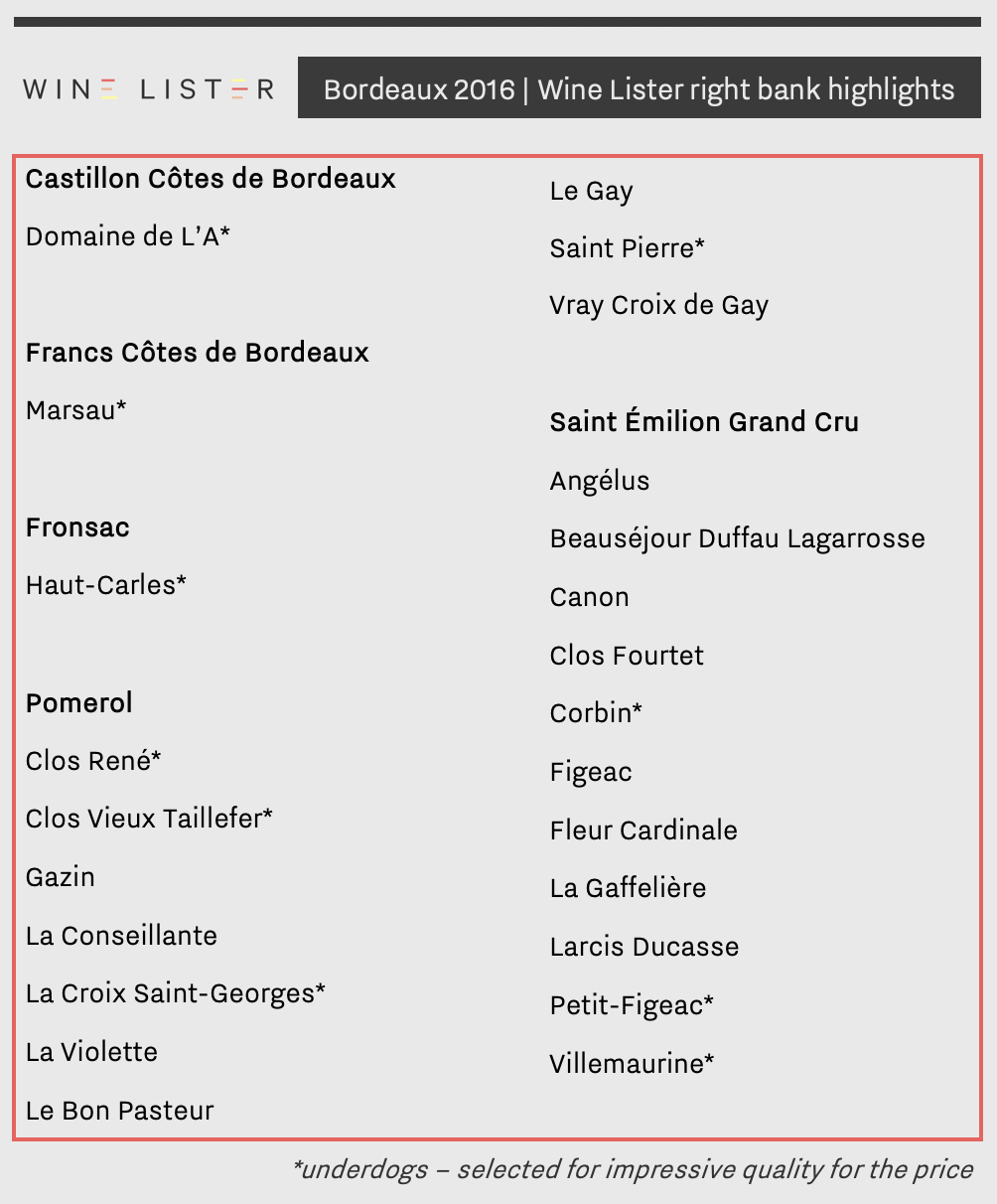 N.B. The tasting did not include wines such as Petrus, Le Pin, Vieux Château Certan, Trotanoy, Ausone, Cheval Blanc, or Pavie.
N.B. The tasting did not include wines such as Petrus, Le Pin, Vieux Château Certan, Trotanoy, Ausone, Cheval Blanc, or Pavie.
However, it was Pomerol that produced more “underdogs” than its neighbour: not-so-big names punching above their weight. Of particular note were Clos Vieux Taillefer and La Croix Saint-Georges.
Among Pomerol top dogs, La Violette was showing beautifully, with a “delicate, fresh” nose and “unctuous, satin” palate. Vray Croix de Gay was “refined” and “thoroughbred”, while La Conseillante produced a “gorgeous, fine-grained texture”.
Further afield, Domaine de l’A from the Côtes de Castillon impressed, as did Marsau, from Francs Côtes de Bordeaux.
Also included in Bordeaux 2016 right bank picks were: Gazin, Saint Pierre, Le Gay, Beauséjour Heritiers Duffau Lagarrosse, Larcis Ducasse, Angélus, Villemaurine, Fleur Cardinale, Clos René, Corbin, and Petit Figeac.
Last week Wine Lister shared top picks from Burgundy 2017 tastings. This week the focus is Bordeaux, after Wine Lister’s founder, Ella Lister, re-tasted through the 2016 vintage with Wine Lister partner critics Michel Bettane and Thierry Desseauve, thanks to négociants Joanne and CVBG.
We are in the process of updating Wine Lister Quality scores based on new, in-bottle scores from Wine Lister partner critics Bettane+Desseauve, Antonio Galloni, and Neal Martin, and in the meantime we share Ella’s left bank picks below.
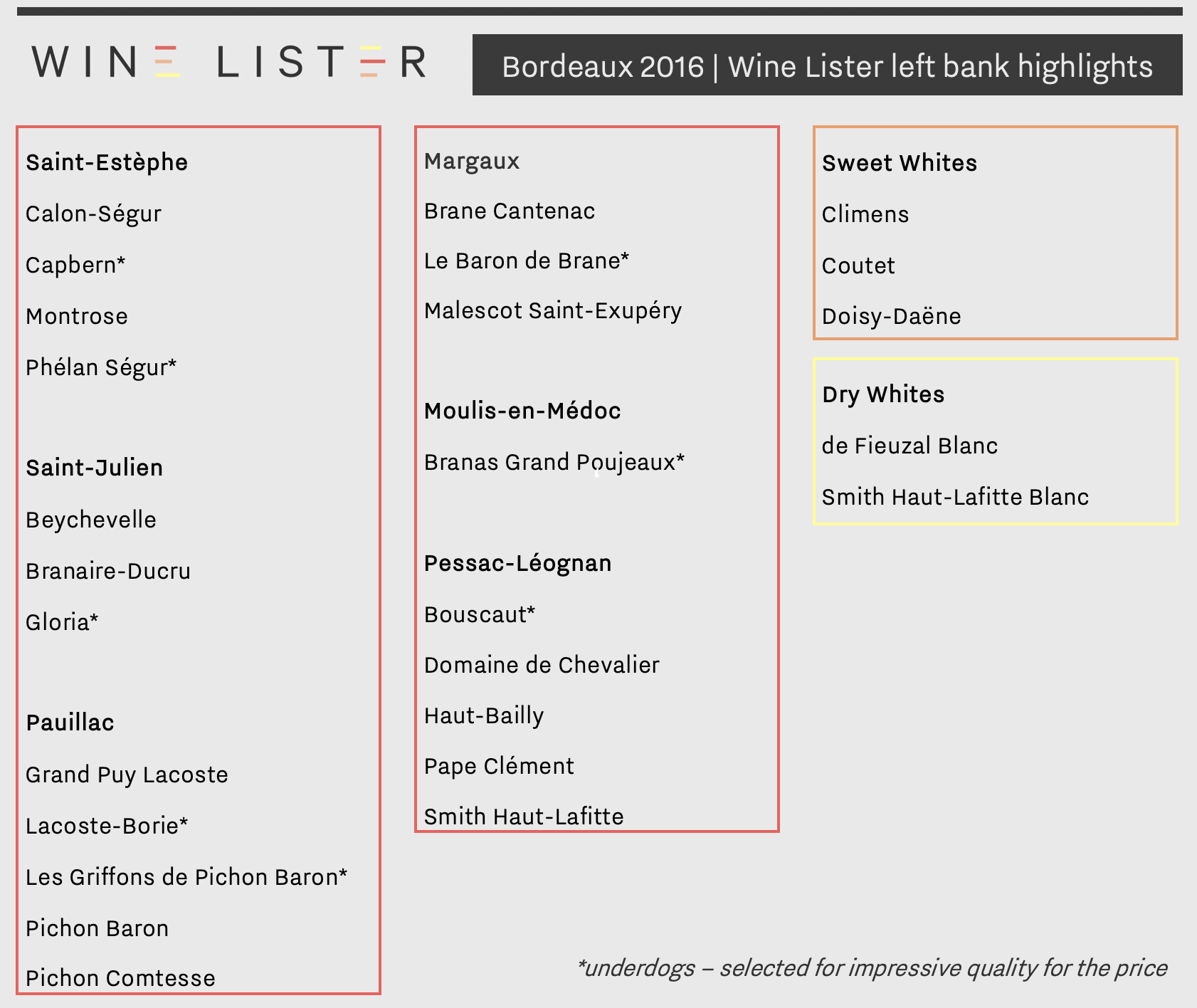 N.B. The tasting did not include first growths, or wines such as Cos d’Estournel, Palmer, Léoville Las Cases, Ducru Beaucaillou, and Pontet-Canet.
N.B. The tasting did not include first growths, or wines such as Cos d’Estournel, Palmer, Léoville Las Cases, Ducru Beaucaillou, and Pontet-Canet.
The spread of favourites from across left bank appellations reflects the homogeneity of the 2016 vintage overall.
Saint-Estèphe was a standout appellation in 2016. Two top dogs, Calon-Ségur and Montrose earned significant praise – Calon is described as having “ballet slipper poise” and a “core of energetic fruit”, where Montrose appeared “elegant, silky and delectable”, with a much-improved integration of oak than the en primeur sample. Beside these sit two underdogs, Capbern and Phélan Ségur, which punch above their expected qualitative weight.
Saint-Julien earns three picks, with Beychevelle being a particular highlight, hailed “ravishing, with vitality and a satin finish”. In Pauillac, Pichon Baron and Pichon Comtesse were both notable, with the former appearing “refined, aristocratic and accomplished”, the latter “exciting, racy, and moreish”. Both Brane-Cantenac and Malescot Saint-Exupéry brought signature Margaux elegance to the tasting mix.
Pessac-Léognan reds were showing particularly well, earning an equal number of highlights as powerhouse Pauillac overall. Haut Bailly made the cut alongside Domaine de Chevalier, Pape Clément and Smith Haut-Lafitte. Bouscaut stood out as the underdog of the Graves.
A few further surprises arose across red appellations, including Gloria, Lacoste-Borie (the second wine of Grand-Puy-Lacoste), and Branas Grand Poujeaux.
Less surprising was the high quality of sweet staples, Climens, Doisy Daëne, and Coutet. Of dry whites, the stand-outs were Smith Haut-Lafitte Blanc (labelled “tonally a step above”), and de Fieuzal Blanc.
Other wines featured in the Bordeaux 2016 left bank highlights are: Branaire-Ducru, Le Baron de Brane, and Les Griffons de Pichon Baron.
One of the major trends identified in Wine Lister’s first Champagne study was the rise of grower Champagnes. While maison offerings dominate the top 20 highest-quality Champagnes from the basket of 108 studied, growers achieve a higher average Quality score overall (862 vs. 853). This week’s top five looks at the top Champagnes under £100 by Quality score, and helps us examine the grower vs. maison phenomenon further.
The first of this week’s top five is grower Champagne Egly-Ouriet’s Vieillissement Prolongé Extra Brut with a Quality score of 919. Though top of the leader board for Quality, it is the least expensive of this week’s group at an in-bond per bottle price of £55 (or 34% less than the average price of the other four Champagnes). This is perhaps due to it being the only non-vintage Champagne of the group, and provides testament to the great price to quality ratio of N.V. Champagnes across the board.
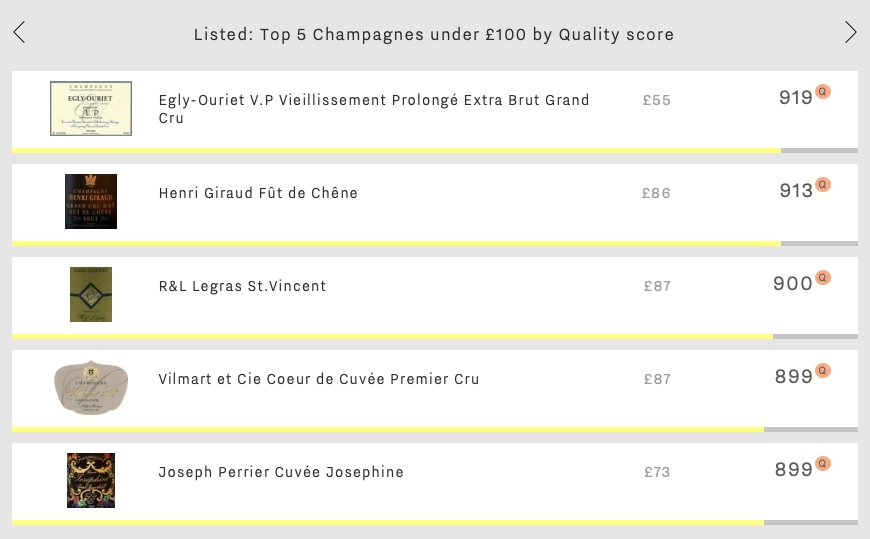
Next up of this week’s top five is Henri Giraud’s Fût de Chene with a Quality score of 913. For the purposes of Wine Lister’s Champagne study, Henri Giraud was in fact not classed as a grower Champagne, since our definition of ‘grower’ signified properties who use 100% of their own grapes (Henri Giraud buys in 20%). The 1999 vintage earns 18 points from Wine Lister partner critic Jancis Robinson, who calls it “a sort of Montrachet of Champagne”.
Third of this week’s top five is R&L Legras’ St. Vincent. Earning a Quality score of 900, it is the only Blanc de Blancs of the group. In true grower fashion, this little-known Champagne ranks as the 1,985th most-searched-for wine of the c.4,000+ wines on Wine Lister and is present in just 3% of the world’s best restaurants.
The last two Champagnes of this week’s top five may have the same Quality score of 899, but have very different profiles. It is surely a satisfying conclusion that, despite maison Champagne’s stronger brand position overall, these two wines (one maison and one grower) prove the opposite to be true. Maison offering Joseph Perrier’s Cuvée Josephine has the lowest Brand score (474) of this week’s top five, while grower Champagne Vilmart et Cie Coeur de Cuvée earns the highest (779), with a search rank in 854th place and presence in 11% of the world’s best restaurants. The rise of grower Champagnes is in full force.
For a more in-depth look at Champagne, subscribe or log-into read the full report here. Alternatively, all readers can access a five-page executive summary. (Both versions are also available to download in French).
Much of the U.K. wine trade gathered last week for the first wine ‘event’ of 2019 – Bourgogne Week. To the Wine Lister team members attending tastings in London, one thing was abundantly clear – the quality across the board is impressive (Wine Lister’s founder, Ella, discussed what a positive surprise the 2017 Burgundy vintage has been in a recent podcast – watch here).
Since there is so much to choose from, and with Burgundy’s popularity continuing to grow (read more in Wine Lister’s Burgundy study here), the Wine Lister team has put together its own list of buys based on tastings attended last week.
The Côte de Nuits has produced many rich examples in 2017. All of Comte Liger-Belair’s wines were stunning, but a particular highlight was his Vosne-Romanée. Both Clos de Vougeots from Faiveley and Jacques Prieur possessed great intensity, while Fourrier’s Gevrey-Chambertin Combe aux Moines was pretty and elegant in style.
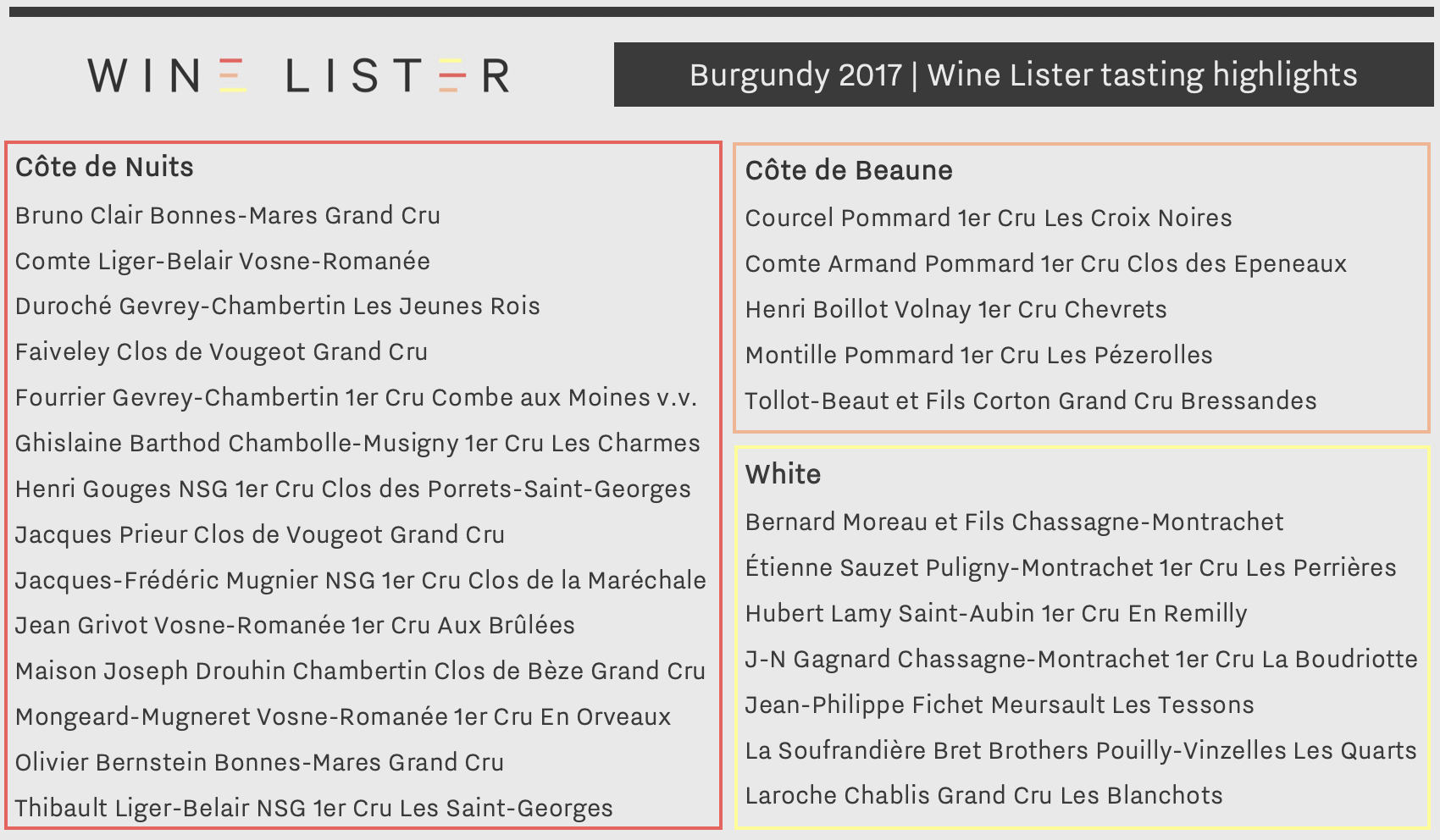
The Côte de Beaune has performed wonderfully in 2017. The team settled on a Volnay, a Corton Bressandes and three Pommards, with two particular favourites – Comte Armand’s Clos des Epeneaux and De Montille’s Les Pézerolles.
Finally, the team were impressed by an array of whites from the Mâconnais right up to the premiers crus from the Côte de Beaune. Hubert Lamy’s Saint-Aubin En Remilly was selected unanimously by Wine Lister team members. Bernard Moreau’s Chassagne-Montrachet impressed, while Bret Brothers’ Pouilly-Vinzelles Les Quarts was a great discovery.
See the rest of the wines included in this post here: Bruno Clair Bonnes-Mares, Duroché Gevrey-Chambertin Les Jeunes Rois, Ghislaine Barthod Chambolle-Musigny Les Charmes, Henri Gouges Nuits-Saint-Georges Clos des Porrets-Saint-Georges, Jacques-Frédéric Mugnier Nuits-Saint-Georges Clos de la Maréchale, Jean Grivot Vosne-Romanée Aux Brûlées, Maison Joseph Drouhin Chambertin Clos de Bèze, Mongeard-Mugneret Vosne-Romanée En Orveaux, Olivier Bernstein Bonnes-Mares, Thibault Liger-Belair Nuits-Saint-Georges Les Saint-Georges, Courcel Pommard Les Croix Noires, Henri Boillot Volnay Chevrets, Tollot-Beaut Corton Bressandes, Étienne Sauzet Puligny-Montrachet Les Perrières, Jean-Noël Gagnard Chassagne-Montrachet La Boudriotte, Jean-Philippe Fichet Meursault Les Tessons, Laroche Chablis Les Blanchots.
At the end of November Wine Lister spent three days in Burgundy meeting with producers across the length of the Côte d’Or. With more wine in their barrel cellars than for a very long time (in some cases more than ever), the mood was light and easy. The 2017 vintage saw the first normal-sized crop since 2009 (and 2018 was even more generous). “It’s the first year we’ve had barrels three rows high,” marvelled Thibaut Gagey as he showed me round Maison Louis Jadot’s vast cellars in Beaune, currently housing a record 6,000 fûts.
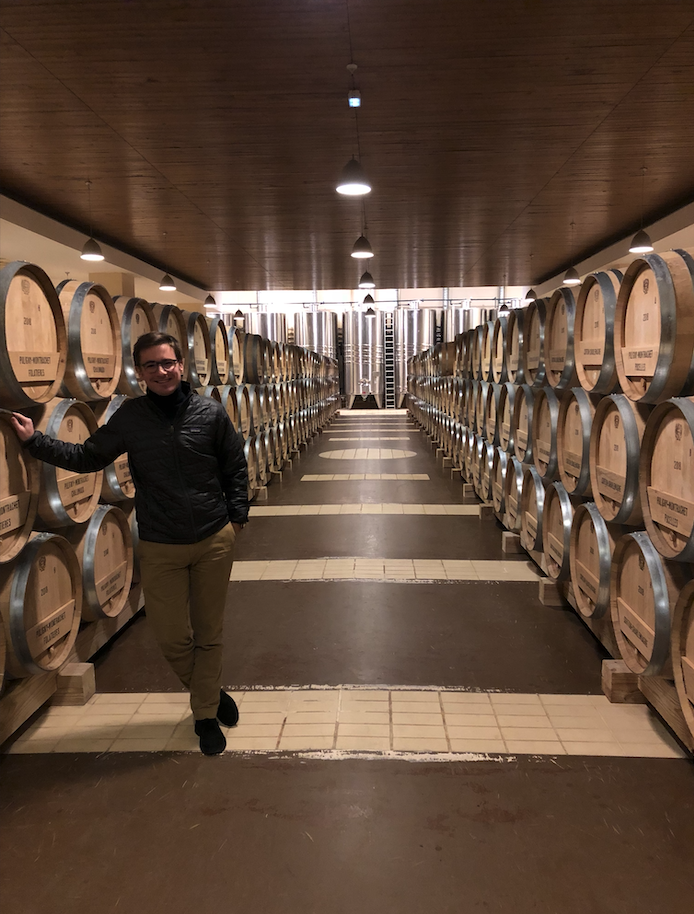
Thibaut Gagey in the Maison Louis Jadot cellars
The 2017 vintage is a “belle surprise” for Gagey, who admits, “we weren’t very confident at first.” This pleasant surprise was something expressed time and again by growers during our tastings of 2017 from barrel. With Burgundy Week about to unfold, here we look back over some of those conversations.
In Volnay, Guillaume d’Angerville calls the 2017 “a huge positive surprise.” He explained that “a lot of people had discounted the vintage early on,” because “they thought it would be diluted.” Our tastings, at Domaine d’Angerville and elsewhere, proved this supposition to be mistaken, the wines having taken on weight and complexity during their élevage. Jasper Morris MW refers to 2017 wines as “relatively homogenous, some with more concentration and others with less.” Either way, the wines are juicy, luminous, and downright delightful.
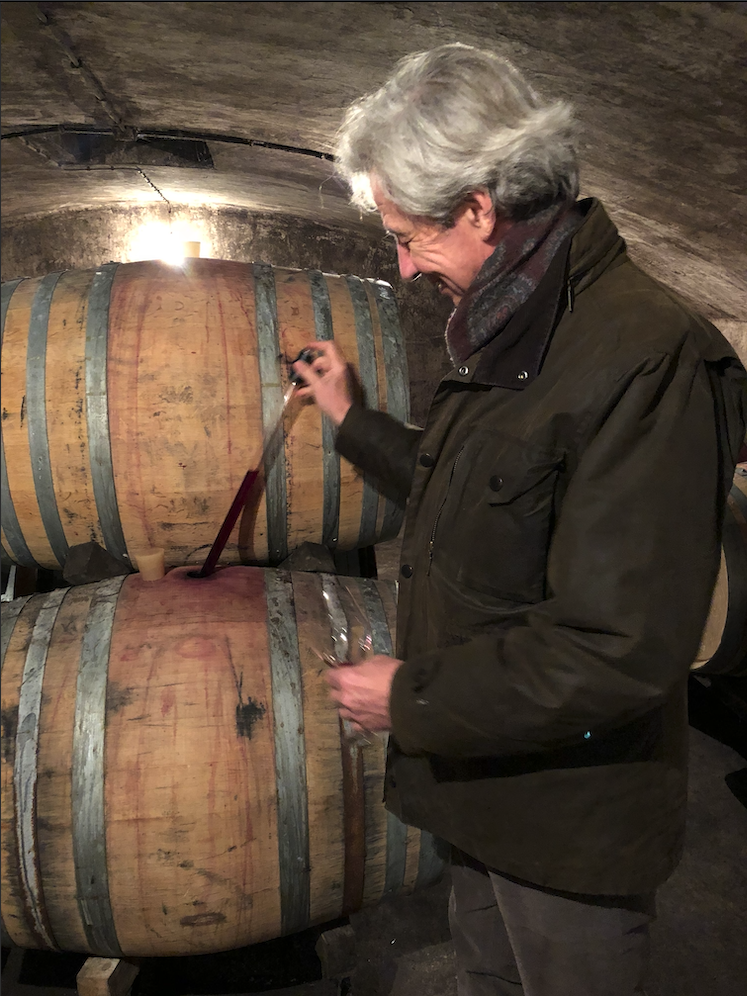
Tasting from barrel with Guillaume d’Angerville
Boris Champy, Manager at Domaine des Lambrays, calls the vintage both “classic” and “modern” at once, because he believes there’ll be many like it in the future. He compared 2017 to 2009. Angerville is reminded of the “tenderness” of 2007 (“but more substantial”) and the “harmony and elegance” of 2002 or 2010. “It’s going to give a lot of pleasure,” he pronounced. Gagey also cited 2007 for its positive surprise factor, and 2014 for its “accessibility”. The immediate pleasure these wines offer up is almost disconcerting, but this early approachability does not mean they won’t age. The 2017 might not be the longest-lived vintage, but it has everything in place for a good innings.
However, it “won’t be the vintage of the century,” Gagey states. “What it doesn’t have is that extra grip, depth, and drive of a great vintage,” confirms Morris. Meanwhile, the whites are superlative. “Apart from 2014,” Morris calls it the “most consistently good white vintage for a long time.”
The growing season was early, but otherwise unexceptional, apart, of course, from the threat of frost once more rearing its ugly head. This time, though, the Burgundians fought their nemesis with a thick veil of smoke. The fires they lit around their vineyards may have served to raise the temperature a fraction, but just as importantly, their smoke prevented the morning sun being magnified through the ice and burning the buds. And so, apart from in Chablis, yields were back to normal levels.
One might assume therefore that prices will come down – after all, the consistent increases over the last eight years have been put down to limited supply. This would be naïve, though, with global demand and secondary market values for Burgundy’s top wines continuing to spiral upwards, even to the bewilderment of some Burgundians (after the record-breaking results of the latest Hospices de Beaune auction of 2018 wines in November, Louis-Fabrice Latour, president of the BIVB (Bureau interprofessionnel des vins de Bourgogne), said he was “surprised prices went up, and by so much”).
The fact is, momentum is with Burgundy. The region’s top 50 wines grew in popularity by 26% over the last year, while Bordeaux’s search rank on Wine-Searcher remained stable, and other regions saw search levels drop. This means that top producers can almost certainly raise prices again this year and still sell through. We spoke to a few domaines who planned to do so, and some by significant margins. Mostly, though, prices should be flat on 2016 or see only modest increases (less than 10% up on 2016 prices). A minority have even come down in price. Either way, this is surely a vintage worth getting your hands on for unadulterated drinking pleasure.
Wine Lister’s Burgundy Market Study published this time last year for subscribers is now free for all to read. Download it in English or in French.
 The price performance of Bordeaux compared to four other key fine wine regions: Burgundy, California, Piedmont, and Tuscany. The price indices comprise the top five wine brands in each respective region.
The price performance of Bordeaux compared to four other key fine wine regions: Burgundy, California, Piedmont, and Tuscany. The price indices comprise the top five wine brands in each respective region. The average search rank of Bordeaux compared to four other key fine wine regions: Burgundy, California, Piedmont, and Tuscany. Results are based on the average searches on Wine-Searcher for the 50 top-scoring wines per region over the last year.
The average search rank of Bordeaux compared to four other key fine wine regions: Burgundy, California, Piedmont, and Tuscany. Results are based on the average searches on Wine-Searcher for the 50 top-scoring wines per region over the last year.

 Results from Wine Lister’s 2020 trade survey show Les Carmes Haut-Brion achieves first place for sharpest rise in demand of Bordeaux wines.
Results from Wine Lister’s 2020 trade survey show Les Carmes Haut-Brion achieves first place for sharpest rise in demand of Bordeaux wines. Four releases from Tuesday 23rd June land within the top 10 Bordeaux wines to be voted by key members of the trade as most likely to see future prestige – Les Carmes Haut-Brion, Vieux Château Certan, Canon, and Rauzan-Ségla.
Four releases from Tuesday 23rd June land within the top 10 Bordeaux wines to be voted by key members of the trade as most likely to see future prestige – Les Carmes Haut-Brion, Vieux Château Certan, Canon, and Rauzan-Ségla. A different time – a throwback to 2018 and a celebration at Château Berliquet, of its acquisition by the Chanel group.
A different time – a throwback to 2018 and a celebration at Château Berliquet, of its acquisition by the Chanel group.


 N.B. The tasting did not include wines such as Petrus, Le Pin, Vieux Château Certan, Trotanoy, Ausone, Cheval Blanc, or Pavie.
N.B. The tasting did not include wines such as Petrus, Le Pin, Vieux Château Certan, Trotanoy, Ausone, Cheval Blanc, or Pavie. N.B. The tasting did not include first growths, or wines such as Cos d’Estournel, Palmer, Léoville Las Cases, Ducru Beaucaillou, and Pontet-Canet.
N.B. The tasting did not include first growths, or wines such as Cos d’Estournel, Palmer, Léoville Las Cases, Ducru Beaucaillou, and Pontet-Canet.


